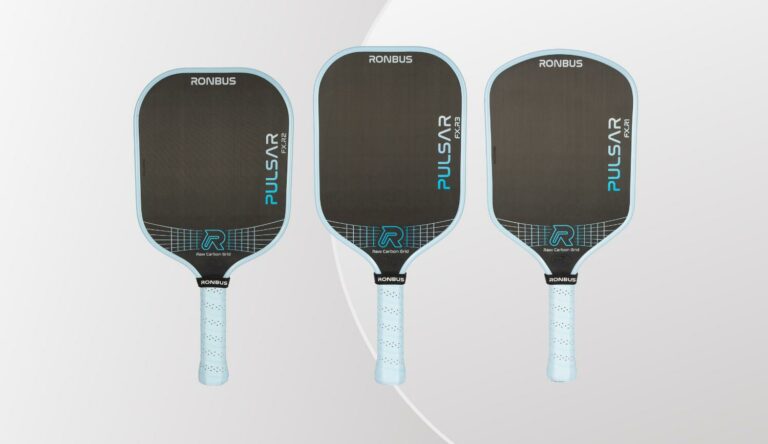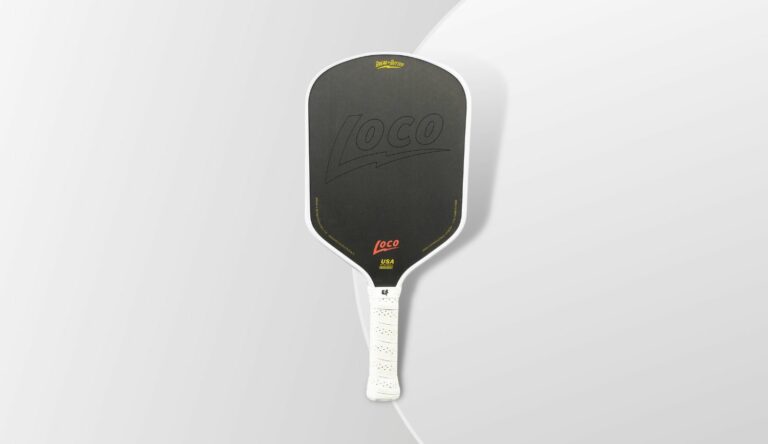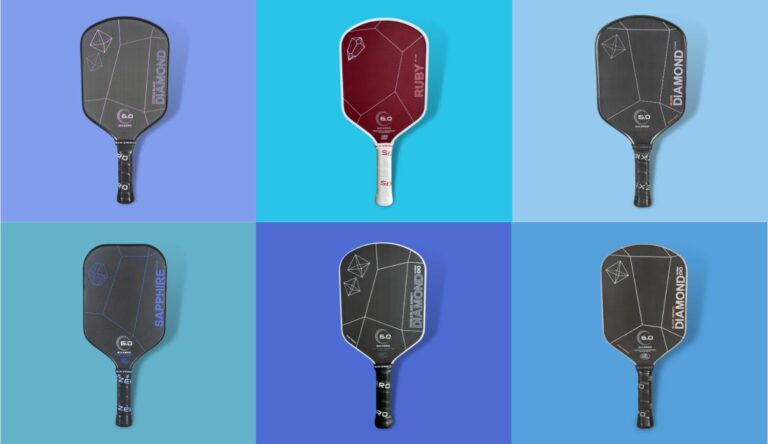Welcome to my pickleball tips series. This is an ever-evolving list of advice for how to work your way through the intermediate skill level of pickleball. I’m always adding new tips to this list, so feel free to bookmark it.
You can also check out my beginners pickleball tips as well. And you should definitely read my post on the worst pickleball tips that you should be avoiding.
Contents
- 1. Dial in your footwork
- 2. Develop your patience
- 3. Be intentional – know why and where you’re hitting each shot
- 4. Know when to move up and when to stay back on drops
- 5. Know when to back off the kitchen line
- 6. Don’t give up the non-volley zone line unnecessarily
- 7. Develop a strategy of unpredictability
- In Conclusion
1. Dial in your footwork
Low-level pickleball players tend to be unaware or lazy about footwork. This results in a lot of missed opportunities.
From getting caught out of position to missing make-able shots, your footwork plays a huge role in your success. This is especially true for difficult shots like the 3rd shot drop which require solid mechanics.
You can’t be lazy on your feet if you want to get to play at an advanced level. Focus on positioning yourself so that you’re never reaching too far or hitting the ball too close to your body.
You want your footwork to become second nature so that you’re always positioning yourself to have space to move forward into a shot with proper technique.
2. Develop your patience
In pickleball, patience wins. You’ll really start to separate yourself from the beginner players when you take a step back and slow the game down in your head.
Think about how many points you’ve lost because you got impatient. You went for the big shot at the wrong time by being overeager instead of methodically setting up a quality putaway opportunity.
Being patient and methodical will help you conquer higher-level opponents that you wouldn’t be able to hang with if you were being anxious or feeling rushed to win the point. When you take your time you make better decisions and create opportunities that force your opponents into impatient decision making.
As you get comfortable with a slow and patient game, you’ll develop the mental resilience to adopt high-level strategies that slowly lure your opponents into traps.
3. Be intentional – know why and where you’re hitting each shot
The majority of players that make it to the intermediate level do so by developing a wide shot selection. But most still don’t understand the deeper strategies behind each shot and how to best take advantage of opportunities to hit them.
To break into the higger 4.0+ intermediate range, you’ll want to know the why and when of all the shots in your arsenal. You’ll want to know why and when you should be dinking, why you’ll want to vary between third shot drops and drives, when to reset the ball, when to speed up, etc.
And then there’s placement. You might know who you’re hitting to and what shot, but are you keying into where you’re trying to place the ball? Are you thinking about sending your drive or dink to their backhand? Or hitting your return deep and to the middle?
It takes time and skill to hit precise balls each time. But it all starts with awareness and intention. You must do this well to progress through the intermediate levels of pickleball. If you neglect these strategies and just go through the motions, you’ll get taken advantage of.
4. Know when to move up and when to stay back on drops
Good drop shots, particularly on the third shot, are essential weapons for intermediate-level play. But your positioning after the drop is just as important as the drop itself. Because if you don’t take advantage of a good drop, you won’t extract much benefit from it.
Move forward on good drops. You want to take every opportunity to get to the NVZ line. Whenever you or your partner hit a drop that’s non-attackable, be quick to take the opportunity to move up. If you can’t make it all the way to the NVZ line, plant yourself in a ready position in the transition zone and be ready to defend.
Stay back on bad drops. Yes, you want to take advantage of opportunities to get up to the kitchen. But a bad drop is not an opportunity, it’s a trap. You want to read how good your team’s drop is as soon as it’s hit. If the drop is bad, i.e. attackable by the opponent, then you’ll want to stay back so you can defend a drive or smash.
5. Know when to back off the kitchen line
Proper court positioning becomes critical as you move up to higher levels of pickleball play. At the intermediate level, you’ll encounter players who have a ton of power and hand speed, and you’ll need to adapt with proper court movement.
Things really speed up at the kitchen/NVZ line. There will be times when you are battling it out at the NVZ line and you’ll start to lose the edge in the point. It’s these times that you should consider giving up some ground by stepping back off the kitchen line to allow yourself more time to respond to your opponent’s attacks.
Another time you’ll want to do this is when your team has laid up a high, attackable ball that your opponent is likely to smash at you. If you stay up at the line, you’re likely going to have no time to react and get smashed on. If you step back, you alleviate some of this pressure and give yourself a much better chance to react and keep the point alive.
And finally, sometimes you’ll face dedicated lobbers. If you’re not incredibly tall, you’re going to need to rush back to cover some of these lobs. In these instances, it might occasionally be worth the risk to back off the kitchen just a bit when you’re anticipating a lob.
6. Don’t give up the non-volley zone line unnecessarily
Yes, you do want to back off the kitchen line in certain circumstances. But you do not want to be heedless about it, either.
I’ll often see players in the 4.0 to 4.5 range backing off the kitchen line unnecessarily, and it’s part of what’s keeping them below 5.0.
You want to hold that kitchen line adamantly unless you have a good reason to. If you find yourself drifting off the NVZ line due to poor footwork or a lack of awareness, know that you’re giving your opponent the advantage by taking pressure off of them and giving them more time to react.
So don’t dance around the line and be sporadic. Hold your positioning and be in a strong ready position. This will keep you balanced and aggressive and will force your opponent to be ready with quick anticipation. It will also make it harder for them to hit drops you can’t snag out of the air.
This is also another reminder about footwork. You want to keep your steps short and compact at the kitchen. You can avoid running backwards and forwards unnecessarily by focusing on slide stepping horizontally and keeping the ball in front of you as much as possible.
7. Develop a strategy of unpredictability
You put yourself at risk in intermediate play if you repeatedly apply the same strategies and use the same shots against your opponent.
Good players will analyze your patterns of play in an effort to counter your game. They’ll be able to lock into your playstyle and apply a ton of pressure with targeted counterplay if you do the same thing point after point.
So focus on keeping your play style varied and unpredictable. Use the element of surprise to catch your opponent off guard and keep them unsure of your next move.
You can apply all sorts of strategies here. You can lull them into complacency by hitting the same shot rhythmically and then abruptly hit them with a new shot out of the blue when they least expect it. Or, you can intimidate them out of the gate by using the full repertoire of your most advanced shots to find potential weaknesses and then slowly exploit them throughout the rest of the game unexpectedly.
With that said, don’t go too crazy with this or your play will become sporadic and you may lose sight of your core strategies. Spice things up just enough to keep your opponent on their toes while employing a patient and steady overarching strategy to wear them down.
Be sure to remember to play to your strengths and your opponent’s weaknesses. Don’t just throw in a drive randomly because it’s different if your drive isn’t that great and your opponent has quick hands and great counters. Focus on what’s best for each specific scenario and deviate only when it makes sense.
In Conclusion
Good luck out there and I hope these tips help your game. Did any tip on this list stand out to you in particular? Do you think I’ve left any good intermediate-level tips off of this list?
Let me know in the comments below.
Keep reading:
- 8 Beginner Pickleball Tips to Upgrade Your Game (2.0-3.0+)
- The 8 Best Pickleball Paddles for $100 or Less in 2023, Ranked
- 7 Quick Tips for Fast Hands in Pickleball | Win Volley/Hands Battles
- 14 Pickleball Singles Tips & Strategies to Help You Dominate the Court
- 15 Worst Pickleball Tips – Ignore This Advice to Improve Your Game






